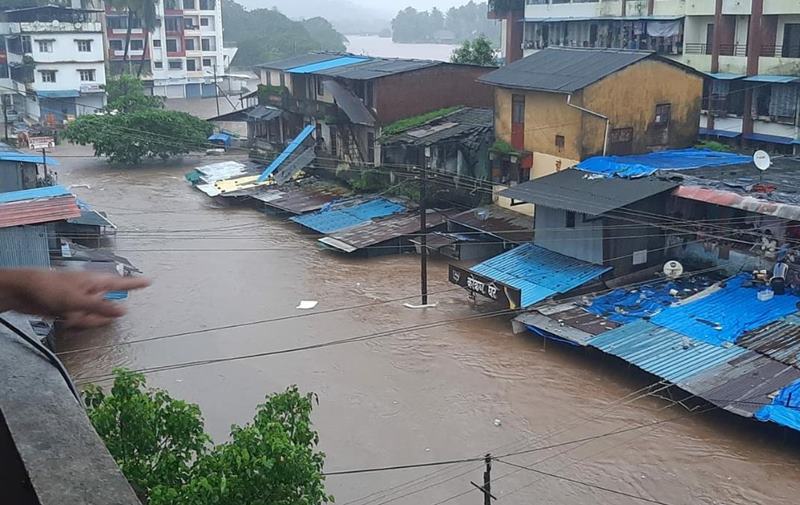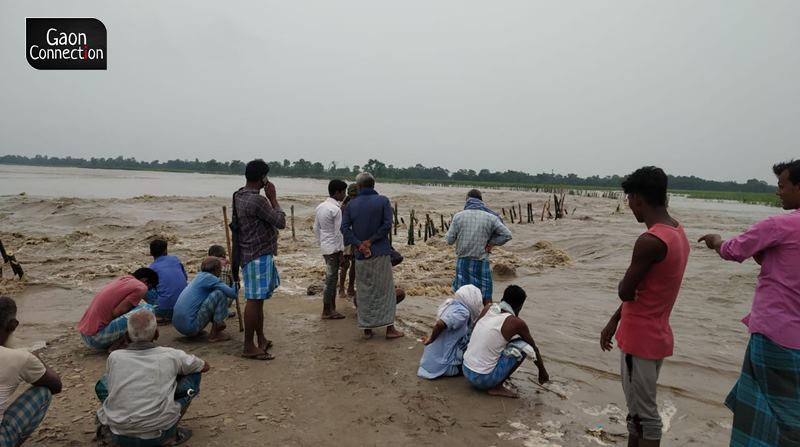Prolonged dry spell period followed by bursts of heavy rainfall is going to be the new normal, warn climate scientists
Experts warn that the extreme weather events, such as Maharashtra floods and Himachal landslides, are expected to rise further in the wake of global warming and climate change as monsoon rainfall patterns have changed in India.


Raigad, Kolhapur and Satara districts in Maharashtra are most affected by the extremely heavy downpour in the past one week. Photo: Twitter/Tamim Kazi
The July month of the southwest monsoon this year has been associated with extreme rainfall events across the country with several states struggling with floods and heavy losses associated with them. Maharashtra, Goa, parts of Karnataka, Telangana have been witnessing floods.
Bihar has been braving floods for almost a month now with a weather forecast of more heavy rainfall in the coming days, which is likely to worsen the floods situation there. Heavy rainfall has induced flash floods and landslides in Himachal Pradesh and Uttarakhand. On July 25, nine people died following a landslide in Himachal. Uttarakhand too has been reporting a series of landslides since the beginning of the month.
Also Read: Torrential rains, rivers-in-spate and landslides leave Uttarakhand in troubled waters
Reportedly 192 people have lost their lives in rain-related incidents in Maharashtra. Raigad, Kolhapur and Satara districts in the state are most affected by the extremely heavy downpour in the past one week. Rescue operations are still underway. Over 229,074 people have been evacuated from flood-affected districts in the Konkan region and western Maharashtra to safer places.
In Bihar, India’s most flood-prone district, over 800,000 people in 15 districts of north Bihar are facing floods for a month now. Hundreds of villages are marooned, homes and toilets are broken, and there is an acute shortage of safe drinking water and food being reported from the flood-hit areas.
Extreme rainfall and climate change
Climate scientists and weather experts point towards the link between the changing climate and these extremely heavy rainfall events. For instance, as per the India Meteorological Department (IMD) data, between 8:30 am on July 22 and 8:30 am on July 23, Mahabaleshwar, a hill station in Maharashtra, received almost 600 millimetre (594 mm) rainfall in 24 hours thereby breaking all its previous records of rainfall. Its previous record of the highest single day rainfall was 491 mm on August 11, 2008.
Similarly, the all-time record of heavy rainfall has been broken in Satara and Kolhapur districts of Maharashtra too.
In response to the intense rainfall and landslides in Maharashtra, Uttarakhand and Himachal Pradesh, Delhi-based Climate Trends, a media advocacy group, has compiled a short briefing paper based on the reactions of experts.
“The Indian subcontinent’s monsoon system has drastically changed due to global warming. You either have a long spell of drought or heavy downpour. This is going to be the new normal,” said Anjal Prakash, Research Director and Adjunct Associate Professor, Bharti Institute of Public Policy at the Indian School of Business, Hyderabad. He is also the lead author in the 6th Assessment report of the IPCC (Intergovernmental Panel on Climate Change).
“Indian cities, towns and villages need urgent plans for adaptation. A special focus must be on building climate resilient infrastructure and risk management plans as these growing extreme events will impact lives as well as our economies,” he suggested.
Mahesh Palawat, vice president of meteorology and climate change, Skymet Weather, a private weather forecasting agency, explained the reason behind the extreme weather events such as cloudbursts, landslides, heavy rainfall, in the Himalayan region.
“Weather becomes more sensitive in the hilly region, as mountains respond to weather more quickly. With the development of cumulonimbus clouds in the absence of strong upper air winds, they do not tend to travel very long or we can say they are trapped. These clouds then deplete all the water over a certain area which is called cloudburst,” he said.
“Deforestation and continued construction of hydropower plants, roads, hotels or homes have led to loosening of soil, resulting in frequent landslides even with the slightest of rains,” explained Palawat. He also pointed out that Himalayan ranges are ecologically fragile and the smallest impact of climate change can lead to fatal events in mountainous terrains.
Also Read: Bihar Floods 2021: A month on, flood and fury lashes in Bihar

Changing monsoon rainfall patterns
A number of research studies point out how climate change is leading to unpredictable weather extremes and their serious consequences. A recent study by Potsdam Institute for Climate Impact Research, titled ‘Climate change is making Indian monsoon seasons more chaotic’, warned that for every degree Celsius of warming, monsoon rainfalls will likely increase by about five per cent.
“If global warming continues unchecked, summer monsoon rainfall in India will become stronger and more erratic,” warned the study published on April 14 this year.

The fifth Assessment Report cycle of the IPCC, an international organisation working on climate change adaptation and mitigation strategies, concluded that human influence on the climate system is ‘clear’. Scientists are certain that climate change is caused by human activities.
The experts indicated that if global warming and climate change continue to go unchecked, the result would be felt by over 1.3 billion citizens of India as it is one of the world’s fastest growing economies and is at the brink of grave consequences.

